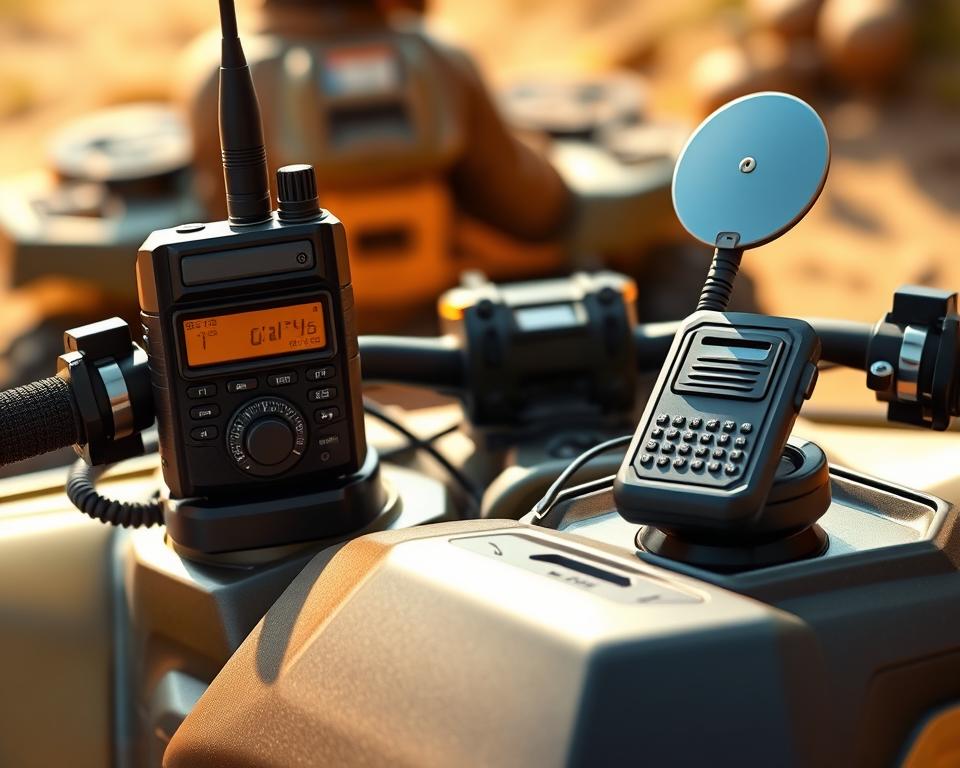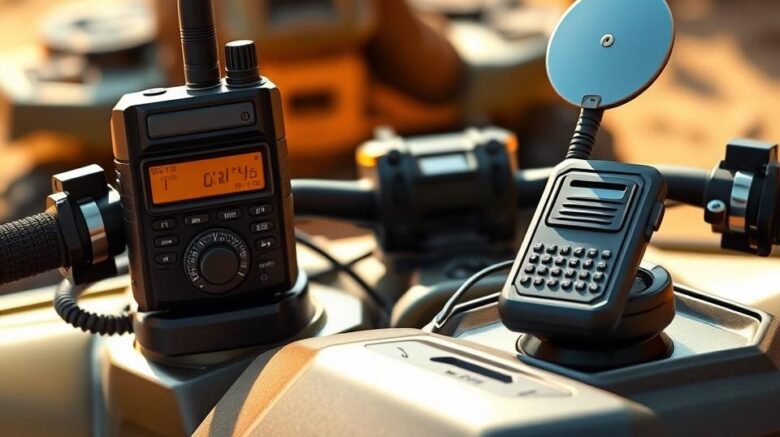Avoiding ATV/UTV Gearing Mistakes for Newbies
Did you realize that nearly 40% of new ATV and UTV owners face gear selection issues within their first year? That figure highlights why beginners need to understand ATV gear ratios. Beyond performance, proper gearing is a key safety factor. Let’s dive into gearing missteps, care routines, and top Can Am maverick x3 windshield with wiper tips to enhance your rides.
Main Points

- Mastering gear ratios unlocks top performance.
- Neglecting gearing details increases accident hazards.
- Routine care averts transmission breakdowns.
- Choosing the right gear boosts trail enjoyment.
- Implementing ATV maintenance tips can prolong vehicle lifespan.
Understanding ATV and UTV Gear Ratios
Ratios determine how engine output translates to drive force. They dictate how engine power translates into speed and torque. This affects acceleration and the vehicle’s ability to pull loads. Custom gearing shifts focus from speed to torque or vice versa.
Choosing the right UTV gear is key to understanding engine performance. Excessively low gearing reduces hill-climbing pull. Conversely, too high a ratio hampers quick takeoffs on flats.
Many enthusiasts use gear reduction to enhance handling and adaptability across different terrains. Tuning ratios lets you fine-tune speed vs. torque. It lets you balance acceleration with pulling force. Achieving the right balance in ATV gear ratios improves the driving experience and boosts efficiency.
Common Gearing Oversights for New ATV/UTV Owners
Proper gear choice underpins both power and protection. Rookies often miss key selection factors. Understanding the effects of wrong gear choices and selecting the right one for your terrain can greatly improve your ride. Plus, it prevents mechanical setbacks.
Impact of Incorrect Gear Selection
Choosing the wrong gear can lead to serious problems, including loss of control and mechanical failures. Incorrect ratios reduce pulling power, hamper braking, and grind parts. These mishaps compromise safety for all on and off board. Adhering to service guidelines prevents such failures.
Choosing the Right Gear for Terrain
Different terrains need different gearing for efficient performance. To conquer grades, use lower speeds and higher torque. On flat terrains, higher gears help increase speed. Mucky surfaces require cautious gearing to maintain momentum. Understanding trail types secures fun and safety.
The Importance of Proper ATV Maintenance
Regular maintenance is key to keeping ATVs and UTVs running smoothly. Adhering to care guides prevents sudden failures and enhances safety. A well-planned maintenance schedule focuses on the gear system’s health.
Regular Inspection and Maintenance
Using a checklist uncovers faults before they escalate. Regularly inspect the drive train, stopping systems, wheels, and belts. By making this checklist a part of your routine, you can greatly enhance your vehicle’s performance. Here are some critical inspection points to remember:
- Inspect gearbox alignment and pitting.
- Check for loose bolts or connections.
- Inspect brake lines and levels.
- Measure wheel pressure and wear.
- Inspect battery terminals and cables for buildup.
Fluid Changes and Gear Health
Fluid quality is critical for UTV drivetrain maintenance. Routine fluid swaps avoid sludge and varnish. Fresh oil cuts wear and heat for lasting components. Using this method secures dependable function and fewer breakdowns.
| Fluid Type | Recommended Change Interval | Benefits of Regular Change |
|---|---|---|
| Engine Oil | 50–100 operating hours | Cuts friction and boosts power |
| Gear Oil | 100–200 operating hours | Improves shifting, minimizes gear damage |
| Antifreeze | Once per year | Prevents overheating, maintains optimal temperature |
Sticking to this plan ensures uninterrupted trail fun. This makes every journey more enjoyable.
Common ATV Gear Shifting Problems
Many beginners wrestle with the gearbox. Mastering smooth shifting techniques can greatly improve the riding experience. This stops shift-related aggravation. Proper coordination of the throttle and clutch is key for control and avoiding shifting problems.
Learning to Shift Smoothly
Building graceful shift habits demands consistent effort. Start by getting to know your ATV engine’s rhythm. Careful engagement protects internals and stops wear. Blending throttle with clutch release ensures seamless shifts.
Practice shifting in a controlled setting until you’re confident. Apply minimal throttle for smooth transitions.
Recognizing Signs of Gear Issues
Early detection of gear issues is essential. Listen for unusual sounds like grinding or popping, which may mean gears aren’t engaging right. Difficulty shifting can also signal problems that need quick attention. Addressing issues promptly protects components and riders. Addressing ATV gear shifting problems properly maintains vehicle performance and boosts your confidence while riding.
Understanding UTV Transmission Issues
Dealing with UTV transmission problems can be tough, but knowing the common issues is vital for troubleshooting. Owners often face issues like slipping gears or odd noises. Here we examine usual faults and outline a step-by-step fix plan. Drawing on proven UTV repair protocols.
Diagnosing Common Problems
Noticing early clues saves you from expensive repairs. Common issues include:
- Slipping gears that threaten control and safety.
- Strange noises signaling internal wear.
- Drips or puddles under the UTV may foretell failures.
Scheduled inspections catch problems fast. It lets you fix faults before they worsen. Overlooking warnings costs more in the long run.
Solutions for Troubleshooting UTV Transmissions
Fixing UTV transmission issues requires a systematic approach. Follow these steps for effective troubleshooting:
- Check fluid levels and top up if necessary.
- Look for wet spots beneath the transmission.
- Assess internal components for wear or chipping.
- Test drive the UTV at various speeds to monitor gear engagement and responsiveness.
- Reference factory troubleshooting charts for your UTV.
Following a reputable repair manual simplifies diagnosis. Grasping drivetrain theory helps maintain your rig. It greatly enhances your vehicle’s longevity and efficiency.
ATV Clutch Adjustments and Their Benefits
Accurate clutch tuning unlocks seamless shifts. Bad clutch setup leads to gear grind and confusion. Frequent tuning enhances clutch grip and shift precision.
Precision in gear changes is critical. Correctly calibrated clutches enable flawless transitions. That boosts throttle response and enjoyment in every gear.
Neglecting clutch upkeep accelerates wear and reduces power. Regular tuning keeps shifts sharp and the motor lively. It’s critical for both new and seasoned riders to ensure their ATV performs at its best.
Mastering the Art of Gear Shifting
Excelling at transitions elevates your trail adventures. Understanding drivetrain function and shift timing is crucial. Rookies need to practice gear timing. A comfortable cadence leads to smoother transitions and improved performance.
Proficient gear shifting demands practice, across various riding conditions. Understanding when to shift gears based on terrain type enhances control and safety. Downshifting into grades safeguards momentum and balance.
- Practice shifting at low speeds to build confidence.
- Listen and feel each gear engagement.
- Step up to steeper, rougher trails as you improve.
Developing a feel for your machine is essential in mastering gear control. Listen for pitch changes and shudders to guide engagements. This helps determine the optimal moments to shift. That instinctive skill yields seamless shifts and more fun.
Best Practices for UTV Gear Selector Problems
Tackling selector issues calls for scheduled checks and troubleshooting. Regular inspections are key to spotting issues early. Perfecting selector methods wards off glitches. Routine checks should include visual inspections of the selector linkage and fluid levels, which are vital for performance.
At the first sign of trouble, clear debris from the shifter. Unusual noises can also hint at problems. Simple adjustments and cleaning often solve issues without needing major repairs. A routine plan stops small faults from growing.
Logging selector behavior in varied rides highlights issues. These best practices not only extend the gear selector’s life but also make riding safer and more enjoyable.
Tips for Enhancing Gear Performance
Maintaining optimal gear performance requires a proactive approach. Regular maintenance is key to improving ATV efficiency. Monitor fluids, look for damage, and fine-tune as required. Catching nicks before they worsen saves you big bucks.
Picking ideal ratios unlocks quicker revs and seamless cruisin’. Knowing trail types steers your ratio choices. It shapes your bike’s quickness and runway performance. Consulting reputable brands like American Off-Roads, which offer aftermarket modifications, can help with UTV performance enhancements.
Implementing gear performance tips in wheels, springs, and ballast optimization elevates function. Making these adjustments ensures that both ATVs and UTVs handle better in challenging environments. This leads to a more enjoyable riding experience. By using these methods, you’ll tackle trails boldly and relish every moment.
Bringing It All Together
Mastering ATV/UTV gearing is essential for performance and safety. Selecting proper ratios for each trail elevates your experience. By avoiding common mistakes and making smart choices, your off-road trips will be both fun and secure.
You can’t overemphasize regular service for power health. Scheduled maintenance and TLC save you from breakdowns and prolong service. Good upkeep maximizes output and secures your rides in all conditions.
Merging smart ratio choice and regular upkeep yields the best off-road enjoyment. Adopting these practices ensures many memorable rides and adventures in the future.
Frequently Asked Questions
What are the typical gear ratios for ATVs and UTVs?
ATVs and UTVs have gear ratios that vary widely, depending on the model. Typical ratios lie within the 3-to-5 range. Low-end ratios yield higher pulling power. Large ratios favor maximum velocity on smooth surfaces.
Signs of misgearing for different surfaces?
Using the wrong gear can lead to loss of control, excessive engine revving, or poor acceleration. Different grounds need dedicated ratios to maintain traction and speed.
How to know when your machine needs service?
Pay attention to hard shifts, strange sounds, leaky fluid, or waning torque. Scheduling drivetrain inspections stops big failures.
Recommended fluid change intervals?
Aim for a fluid swap between 1,500–2,500 miles or annually, whichever comes first. Pure oils maintain smooth shifts and protect internals over time.
What techniques should I use for smooth gear shifting?
Master the throttle-clutch dance for silky shifts. Gradually release the clutch while pressing the throttle to match engine speed with wheel speed.
Quick fixes for UTV drivetrains?
First, inspect oil, then note any unusual gearbox sounds. Verify oil clarity and fill. Then, perform a basic diagnostic to identify any mechanical failures.
Why adjust your ATV clutch?
Well-set clutches ensure crisp gear changes. Bad clutch alignment wears out parts prematurely and hinders shifts.
Adapt gearing for every surface?
Try different ratio setups and check out trusted upgrades from American Off-Roads. Scheduled service—linkage grease and oil changes—maintains top output.
When your UTV shifter sticks?
Regular inspections and routine maintenance are key. When the shifter binds, use the OEM troubleshooting procedures to find the root cause.
Rookie gearing errors to dodge?
Beginners sometimes skip ratio learning, skip services, or stay in the wrong gear for conditions. These mistakes hamper performance and raise the chance of mishaps.
